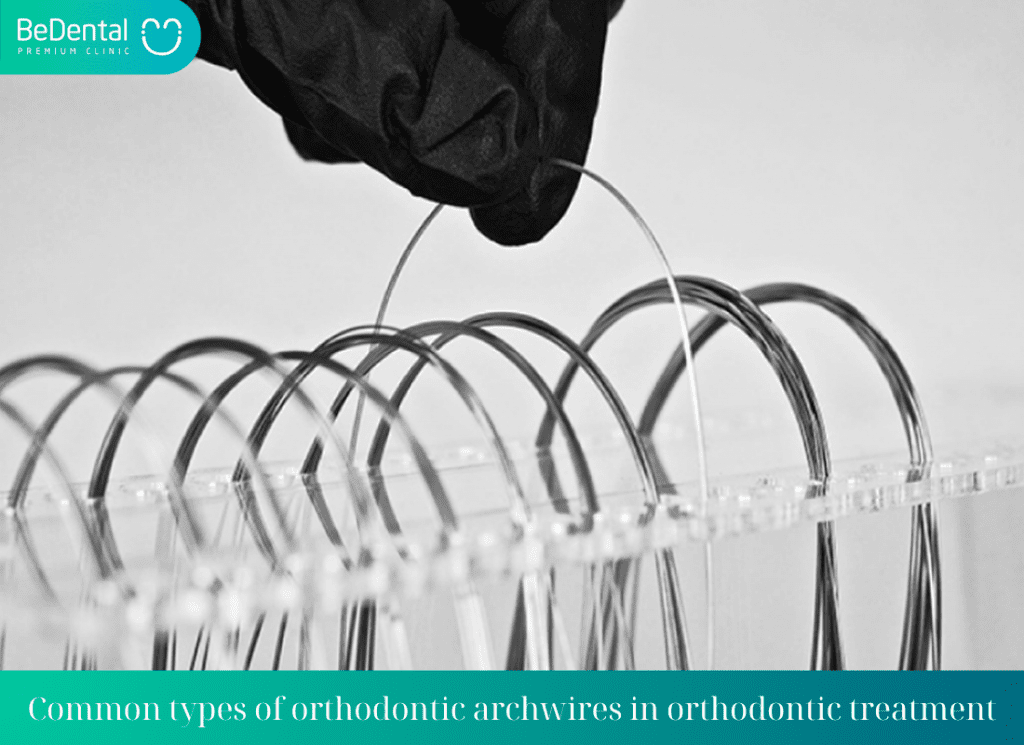Similar to the use of brackets, orthodontic archwires play an important role in traditional orthodontic treatment. So what is orthodontic archwire? What are the common types of archwires? What are some common issues when wearing archwires? And their functions in orthodontics. Below, we will provide detailed information about orthodontic archwires and common issues encountered when using them, to help readers better understand this field and gain more knowledge on the topic.
What is orthodontic archwire?
See more: Signs of gum recession during braces

The role of archwires in orthodontic treatment in different stages
In addition to asking, “What is Orthodontic Archwire?”, customers should know about the role of archwires in orthodontic treatment in different stages. Archwires and elastic bands are two important tools in the process of orthodontic treatment, helping to achieve high effectiveness and a quick process. Both play different roles in each stage of the orthodontic treatment process.

Even teeth alignment stage:
In this stage, it is necessary to use archwires with low rigidity and high elasticity. Niti archwires are a commonly used type, helping to align teeth evenly and bring them to the correct position on the dental arch. This creates favorable conditions for the next orthodontic steps.
Gap closure and teeth tightening stage:
This is the most crucial stage, where you can see significant improvement in the alignment of teeth and facial structure. In this stage, Stainless Steel archwires are often used to adjust the position of the front teeth and correct the discrepancy between the two dental arches.
See more: What is Abutment?
Bite correction and maintenance stage:
In this stage, Niti archwires are commonly used to adjust and maintain stable bite alignment. The time frame for bite correction in this stage is typically between 2 to 8 weeks, depending on each individual’s orthodontic progress.
Common types of archwires in orthodontic treatment
In addition to asking, “What is Orthodontic Archwire?”, customers often seek information about the features and benefits of each type of archwire.

Orthodontic precious metal archwires
In 1887, thanks to the efforts of scientist Edward Angle, precious metal archwires such as gold, silver, and platinum were widely used in the dental field. The main components of this type of archwire include approximately 55-65% gold, 5-10% platinum, 5-10% palladium, 11-18% copper, and 1-2% nickel.
The notable advantages of this type of archwire are its elasticity, high flexibility, and excellent corrosion resistance. However, due to the high production and usage costs, this type of archwire is often not suitable for the majority of users in the dental field.
Stainless Steel archwires
In 1929, stainless steel orthodontic archwires were introduced to the market, becoming the first material to replace precious metal archwires in the orthodontic treatment process. Stainless steel alloys have much lower production costs compared to precious metals.
Additionally, they have high rigidity, corrosion resistance, and flexibility, making them easy to manufacture complex orthodontic appliances. The stainless steel alloys belong to the austenitic “18-8” type, consisting of Chromium (17-25%), Nickel (8-25%), and Carbon (1-2%).
See more: Dental implants
Cobalt-Chromium orthodontic archwires
In the 1950s, cobalt-chromium alloy archwires began to be used in orthodontics, with the main components including cobalt (40%), chromium (20%), iron (16%), and nickel (15%).
These archwires have strong tensile strength but relatively low rigidity, making them unsuitable for treating complex orthodontic cases. Therefore, Cobalt-Chromium orthodontic archwires are now less commonly used in modern treatment methods.
Nickel-Titanium (Niti) archwires

In the 1960s, Nickel-Titanium archwires were developed and researched by scientist William F. Buehler. Since their introduction to the market, they have become the most popular type of archwire in most bracket orthodontic methods.
Nickel-Titanium (Niti) archwires have low rigidity, high flexibility, and elasticity. Its main components are Nickel (55%) and Titanium (45%).
Titanium-Beta (TMA) archwires
Titanium-Beta archwires contain 79% titanium, 11% molybdenum, 6% zirconium, and 4% tin in their composition. The strength of this type of archwire lies in its flexibility in adjusting length, optimizing the efficiency of the orthodontic treatment process impressively.
See more: Do braces cause toothloss?
Ceramic archwires
Ceramic archwires are a special type of archwire with a stainless steel core coated with high-quality ceramic on the outside. This ceramic layer not only creates a white color for aesthetic purposes but also maintains the biocompatibility of the archwire, preventing deformation during use. This type of archwire provides significant and stable pulling force, although its durability may not be as high as some other types of archwires.
However, the advantages of aesthetics and biocompatibility make ceramic archwires a suitable choice for those interested in concealing their orthodontic treatment.
Rectangular orthodontic archwires
Rectangular archwires, commonly known as square archwires, are popular orthodontic archwires used in the process of aligning teeth for gap closure, bite adjustment, and maintaining results after orthodontic treatment. This type of archwire comes in various sizes and customizations to suit specific situations in the teeth alignment process.
Sizes of orthodontic archwires

Orthodontic archwires come in various sizes, and the dentist will use archwires of appropriate sizes for each stage of braces treatment. Below are the common sizes used according to the stages:
- Initial alignment stage: typically use archwires with sizes ranging from 0.014 to 0.016.
- Space closure stage: suitable sizes are 0.019 x 0.025 and 0.016 x 0.025.
- Bite correction and maintenance stage: archwires at this stage usually have sizes around 0.019 x 0.025.
Common issues when wearing archwires
In addition to asking, “What is Orthodontic Archwire?”, customers often seek information about some popular issues while wearing archwires. Archwires are an essential tool continuously used in the process of braces treatment, so many issues can arise during this process. Here are some of the most common issues:

Orthodontic archwire poking into the cheek causing pain
When first worn, a common issue with wearing archwires is that the end of the archwire can cause pain and discomfort when poking into the cheeks. To alleviate this issue, the best way is to use dental wax on the painful area and contact your dentist for a solution.
It is important not to bend the ends of the archwire by yourself, as this can cause the archwire to become misaligned and directly affect the results of braces treatment in the future.
Loose or slipped archwires during braces treatment

Slipped archwires are a common issue that often occurs during the initial stages of orthodontic treatment. At that time, the speed of tooth movement is fast, which can lead to archwires slipping or becoming loose. In this case, you can use dental wax to hold the archwire in place and then visit the dentist to adjust the archwire.
Broken or bent orthodontic archwires
Broken, bent, or twisted archwires are common occurrences during braces treatment, often caused by chewing or external forces. Eating hard or tough foods in the early stages of orthodontic treatment can significantly impact the archwires.
Therefore, it is important to be cautious and limit eating such foods. In the case of broken, bent, or twisted archwires, you should visit the dentist immediately to address this issue as soon as possible to avoid affecting the duration and results of the braces treatment.
Swallowing orthodontic archwires
Swallowing archwires is a very rare occurrence because archwires are made of metal and are difficult to break and swallow into the body. However, if you accidentally swallow an archwire, it can directly affect the digestive system, cause throat irritation, or even more dangerously, perforate the intestines.
Therefore, if you accidentally swallow an archwire, you should immediately contact a dentist for assistance and examination.
See more: Implant osstem
Is changing orthodontic archwires painful?
During the process of changing orthodontic archwires, there may be a feeling of soreness and discomfort due to increased tightening force. However, this feeling will gradually decrease after about 3-4 days from the day of archwire replacement, and the teeth will gradually adjust to the new archwire.
To reduce the discomfort, you can apply cold compress and drink water continuously. This will help alleviate the discomfort during the adaptation to the new archwire.
The above article has helped you answer the question: “What is Orthodontic Archwire?“. Contact Bedental if you want advice on appropriate methods to have more precious information, we will provide free help 24/7.





